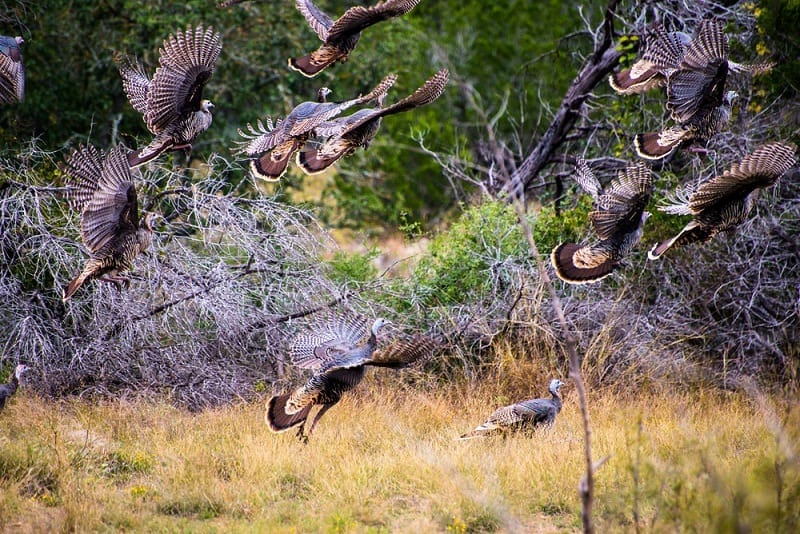The onset of spring brings a wealth of opportunity for the avid bowhunter. As temperatures start to warm, and the spring green-up begins, many bowhunters head afield in search of turkey hunting success. This pursuit is not only enjoyable but also serves as an excellent test of one’s bowhunting prowess.
However, a successful turkey season begins long before opening day. By conducting diligent preseason scouting, you can dramatically increase your odds of filling your tag and place yourself in contention for a spring season like none other.
Contents (Jump to Topic)
ToggleThe following are 6 scouting tips to increase your spring turkey hunting success.
Watch For Flock Dispersal
During the latter half of February and the first of March, turkeys begin deviating from their winter patterns. Large groups of hens and toms break into smaller sub-groups, where flock hierarchy is determined (read.. what do you call a group of turkeys).
You can anticipate this behavioral change to jump-start your spring scouting efforts.
As turkeys disperse into smaller springtime flocks, they typically relocate to new core areas. This relocation can be minor in scale, or rather significant.
However, you can track the movements by scouting local pasture ground, river bottoms, and crop fields. Doing so provides a hunter with the basic information that is necessary to focus their future scouting efforts.
Study Sign
Luckily for hunters, turkeys tend to leave behind an abundance of sign, as they move from one location to the next.
Locating and studying this sign is an excellent way to uncover the habits of a particular flock. The presence of sign can also clue you in to the whereabouts of important locations, such as roost sites and favored food sources
Feathers, droppings, dusting bowls, and scratched spots in the soil are all great indicators of turkey activity.
Additionally, the presence of scratch marks in a “line-like” pattern is often indicative of a strutting area. These marks are left in the soil when a gobbler drops their wings while strutting, thereby dragging their wingtips in the soil.
Scout By Camera
You do not always have to be physically present, in order to accurately scout a particular area. On the contrary, scouting cameras can be employed when scouting prior to turkey season, in much the same way as many hunters use their cameras during deer season.
By positioning scouting cameras over likely food sources, roost sites, and loafing areas, you can quickly confirm the presence of birds in a given area.
Once turkeys have been located, trail cameras can also be used to pin down the times of a particular flock’s movements. Cameras can be placed along fence rows and other likely points of transit, to determine how the birds in a given area move about their home range.
This allows you to intercept a flock during their daily travels, upon the opening of season.
Listen Carefully
Turkeys, by nature, tend to be extremely vocal. An intuitive hunter can key in on this fact, allowing them to locate birds with significant consistency.
However, you must be present in the field, in order to gather this intelligence. Doing so often involves accessing high ground within a given area, where you can hear with a greater degree of accuracy.
This can include ridgetops, hillsides, or prominent bluffs.
In general, turkeys tend to be most vocal early in the morning, prior to their departure from roost. During the springtime, toms will regularly gobble immediately after daylight, giving away their location.
By listening for these post-daylight gobbles before opening day, you can pinpoint roost sites that can be hunted as season progresses. This often serves as one of the most valuable of all preseason scouting techniques.
Log Your Findings
Scouting is of little importance if you do not record your findings for later reference. This places a significant amount of value on keeping a running log of all scouting-related outings.
You can record all relevant information in a simple notebook, or even on a note-style app on your mobile device. As opening day draws near, this information can be used to formulate an effective strategy.
When keeping a scouting log, details such as the date, location, weather conditions, and time of day can all prove worthy of being recorded.
read.. Where Do Turkey Sleep?
Additionally, a detailed description of what was observed when afield should also be notated. Once the season opens, information of this type will prove to be a valuable resource.
Cover Significant Ground
In many cases, turkey hunting can be quite difficult. Hunts do not always go as planned, and promising locations can fall flat. When this occurs, many hunters are left without recourse.
However, such difficulties can be avoided by scouting multiple properties prior to opening day, which can all be hunted with the same degree of efficiency.
This provides you with a back-up option, should your primary hunting spot prove unproductive.
Now is the time to make contact with property owners, in a bid to gain access to various tracts of land for the purpose of turkey hunting.
As season draws near, many of these same landowners will be bombarded by similar requests for access to their property, making it difficult to gain permission.
By taking care of this chore now, you can increase your odds at success, at which point scouting can commence.
Working To Be Lucky
While there is always an element of luck involved with any successful turkey hunt, you can significantly sway the odds in your favor by putting forth effort when scouting before season.
Doing so provide you with the necessary means to hunt smarter, thereby increasing your efficiency when afield.
When applied to a hunter’s specific situation, all of the above-mentioned tips can help prove fruitful when attempting to fill your tags this spring.
With a better understanding of the habits associated with the birds of a given area, you will be armed with every necessary tool to find success beyond that which you might have thought possible.








